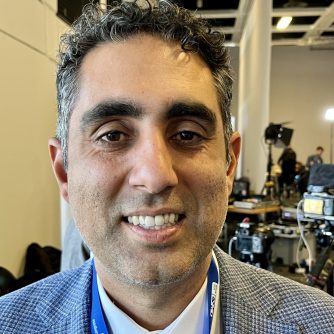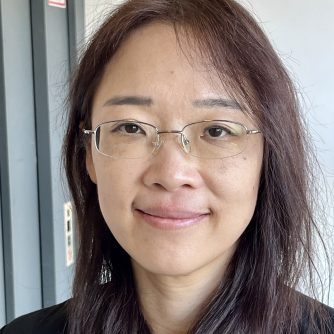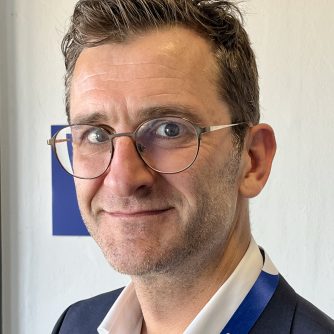
Audio Journal of Oncology: Sept 23rd, 2025
An interview with:
Timothy Yap MD PhD MBBS, Professor of Investigational Cancer Therapeutics, Head of Clinical Development, Therapeutics Discovery Division, University of Texas MD Anderson Cancer Center, Houston, USA
SAN DIEGO, USA—Breast, ovarian, pancreatic, prostate and other solid tumors with mutations sensitizing them to poly ADP ribose polymerase (PARP) inhibition, could potentially be controlled better and with less toxicity with the new selective PARP-1 inhibitor saruparib than with existing licensed agents which inhibit both PARP 1 and PARP 2. That’s according to early results from the PETRA study reported to the San Diego meeting of the American Association for Cancer Research (AACR).
Timothy Yap MD PhD MBBS, Professor of Investigational Cancer Therapeutics and Head of Clinical Development in the Therapeutics Discovery Division of the University of Texas MD Anderson Cancer Center in Houston, reported early clinical data from the PETRA study. After his talk at the AACR conference he discussed the findings with Peter Goodwin.
Timothy Yap MD PhD MBBS: AUDIO JOURNAL OF ONCOLOGY: IN (SARAH M AXWELL): A new class of PARP inhibitor … ….OUT: from me, Sarah Maxwell, Good-bye. 18:45 secs
WHAT IS SARUPARIB? : “Saruparib is an investigational new drug that is being evaluated for the treatment of cancer. It is a first-in-class selective inhibitor of poly-ADP ribose polymerase 1, designed to treat cancers with homologous recombination repair deficiencies as a result of mutations in BRCA1, BRCA2, PALB2, RAD51C, or RAD51D genes.”
AACR ABSTRACT:
Next-generation PARP Inhibitor Demonstrates Clinical Benefit in Patients with
Homologous Recombination Repair-deficient Breast Cancer
PETRA: first-in-human Phase 1/2a trial of the first-in-class new generation poly-ADP-ribose polymerase-1 selective inhibitor (PARP1i) saruparib (AZD5305) in patients (pts) with advanced solid tumors with BRCA1/2, PALB2 or RAD51C/D mutations
AACR Abstract CT007:
PETRA: First in class, first in human trial of the next generation PARP1-selective inhibitor AZD5305 in patients (pts) with BRCA1/2, PALB2 or RAD51C/D mutations
Abstract
Background: AZD5305 is a potent, highly selective PARP1 inhibitor and trapper with superior preclinical tolerability, target engagement and efficacy vs 1st generation dual PARP1/2 inhibitors (PARPi). This is the first report of the ongoing Phase 1/2a PETRA (NCT04644068) trial.
Citation Format: Timothy A. Yap, Seock-Ah Im, Alison M. Schram, Adam Sharp, Judith Balmana, Richard D. Baird, Jessica S. Brown, Maria Schwaederle, Elizabeth A. Pilling, Ganesh Moorthy, Spiros Linardopoulos, Adam Dowson, Carol Pound, Edit Lukacs, Sabina Cosulich, Stephen J. Luen. PETRA: First in class, first in human trial of the next generation PARP1-selective inhibitor AZD5305 in patients (pts) with BRCA1/2, PALB2 or RAD51C/D mutations [abstract]. In: Proceedings of the American Association for Cancer Research Annual Meeting 2022; 2022 Apr 8-13. Philadelphia (PA): AACR; Cancer Res 2022;82(12_Suppl):Abstract nr CT007.
Methods: Pts with advanced breast, ovarian, prostate or pancreatic cancer bearing germline or somatic BRCA1/2, PALB2 or RAD51C/D mutations received AZD5305 QD PO until disease progression. ECOG PS 0-2 and Hb ≥9.0 g/dL were required. Prior PARPi and platinum therapy were permitted. The primary objective was safety; secondary objectives included pharmacokinetics (PK) and pharmacodynamics in tumor and/or blood samples and response by RECIST v1.1, CA125 or PSA. Exploratory genomic analyses included zygosity evaluation and ctDNA response monitoring.
Results: At data cutoff (Nov 17, 2021), 46 pts received AZD5305 10-90 mg QD (43.5% had prior PARPi; median 3.5 prior lines of therapy). AZD5305 was well tolerated across all doses without DLTs. PK exposures were dose-proportional. Steady-state Ctrough was higher than 1st generation PARPi: specificaly 6.3 and 31.9 fold above target effective concentration at 10 and 90 mg, respectively. PARylation inhibition was ≥90% at 10-40 mg QD (PBMCs) confirming target engagement. 7/25 (28%) pts had objective responses: 5 RECIST PRs (3 confirmed) and 2 additional pts with PSA50 responses (1 confirmed), including platinum- and PARPi-resistant pts. 13/22 (59%) RECIST-measurable pts had SD or PR up to 51+ weeks. ctDNA declined on treatment in 7/13 (54%) evaluable pts (3 complete, 4 >50% reductions) across doses.
Conclusions: AZD5305 is a highly selective PARP1 inhibitor and trapper with excellent physiochemical properties and a wide therapeutic index. It led to maximal target engagement and showed promising clinical activity with favorable tolerability at exposures surpassing those of 1st generation PARPi.
MORE: (AACR RELEASE):
Next-generation PARP Inhibitor Demonstrates Clinical Benefit in Patients with Homologous Recombination Repair-deficient Breast Cancer
Drug has higher selectivity for PARP1, improving safety and tolerability
SAN DIEGO – Saruparib, a selective inhibitor of poly-ADP ribose polymerase 1 (PARP1), demonstrated a promising objective response rate and progression-free survival in patients with certain homologous recombination repair (HRR)-deficient breast cancers, according to results from the phase I/II PETRA trial, presented at the American Association for Cancer Researc 2024 Annual Meeting in San Diego.
Although blocking the enzyme PARP1 may be sufficient to prevent DNA repair in HRR-deficient tumors, all PARP inhibitors currently approved by the U.S. Food and Drug Administration (FDA) block both PARP1 and PARP2, which can limit utility because of toxicity, explained Timothy A. Yap, MBBS, PhD, professor of Investigational Cancer Therapeutics and vice president and head of clinical development in the Therapeutics Discovery Division at The University of Texas MD Anderson Cancer Center, who presented the study.
“When we were developing first-generation PARP inhibitors, we weren’t able to increase the doses above a certain threshold because of toxicity,” Yap said. “By designing selective PARP1 inhibitors, we have a great opportunity to improve safety, tolerability, pharmacokinetics, pharmacodynamics, efficacy, and combinability with other therapies.”
Saruparib, a PARP1-specific inhibitor, showed promising tumor growth inhibition in preclinical models of breast ovarian pancreatic and prostate cancer harboring HRR deficiency mutations. Because saruparib was less toxic than other PARP inhibitors, it could be given at higher doses.
“The properties of saruparib enable patients to reach high drug pharmacokinetic exposure levels and pharmacodynamic target engagement,” Yap said. “This means that patients may be able to stay on the optimal dose for a longer duration due to fewer dose interruptions and reductions, which may ultimately improve efficacy.”
PETRA is a multicenter phase I/II clinical trial evaluating the safety, tolerability, and efficacy of saruparib in 306 patients with previously treated (including ≤1 prior PARP inhibitor in the dose escalation phase and PARP inhibitor-naive breast cancer patients in the dose expansion phase) HRR-deficient breast, ovarian, pancreatic, or prostate cancer. Patients had tumors with mutations in one of five HRR genes: BRCA1, BRCA2, PALB2, RAD51C, or RAD51D.
Patients were treated at doses ranging from 10 to 140 mg saruparib daily; 60 mg daily was chosen as the recommended dose for further clinical development. Among the 31 breast cancer patients treated with 60 mg saruparib, the objective response rate was 48.4%, the median duration of response was 7.3 months, and the median progression-free survival was 9.1 months.
In the cohort of 141 patients who received the 60 mg dose across all cancer types, adverse events were observed in 92.2% of patients and 12.1% of patients experienced a serious adverse event. Adverse events related to saruparib were observed in 76.6% of patients, and 2.1% of patients had a serious adverse event related to the drug; 3.5% of patients discontinued treatment due to adverse events related to saruparib.
Yap noted that the adverse events profile from this phase I/II trial of heavily pretreated patients compared favorably to those from phase III trials testing other PARP inhibitors in treatment-naïve patients. “The low rate of dose reductions observed with saruparib suggests a very manageable safety profile that we believe will enable patients to stay longer at the optimal dose and therefore maximize the opportunity for long-term benefit,” Yap said.
Pharmacokinetic analyses showed that, at all dose levels, patients maintained higher blood concentrations of saruparib than typically observed with other PARP inhibitors. At the molecular level, saruparib inhibited around 90% of PARP activity in tumor tissue collected from biopsies.
“The excellent safety and tolerability profile, along with the favorable pharmacokinetic and pharmacodynamic properties, may enable patients to remain on saruparib treatment with sustained maximal target engagement and limited dose reductions or discontinuation,” Yap said.
Limitations of this study include its single-arm design and small sample size.
This study was funded by AstraZeneca. Yap is head of clinical development in the Therapeutics Discovery Division at The University of Texas MD Anderson Cancer Center, which has licensed therapeutics to Artios Pharma. He serves or has served as a consultant for 858 Therapeutics, Inc., AbbVie, Acrivon Therapeutics, Adagene, Aduro Biotech, Inc., Almac, Amgen, Amphista Therapeutics, Artios Pharma, Astex Pharmaceuticals, AstraZeneca, Athena Therapeutics, Atrin Pharmaceuticals, Avenzo Therapeutics, Avoro Capital Advisors, Axiom Real-Time Metrics, Baptist Health System, Bayer, BeiGene, BioCity Biopharma, Blueprint Medicines, Boxer Capital, BridGene Biosciences, Bristol Myers Squibb, C4 Therapeutics, Inc., Calithera Biosciences, Cancer Research UK, Carrick Therapeutics, Circle Pharma, Inc., Clovis Oncology, Cybrexa Therapeutics, Daiichi Sankyo, Dark Blue Therapeutics Ltd., Debiopharm, Diffusion Pharmaceuticals, Duke Street Bio Ltd., EcoR1 Capital Fund, Ellipses Pharma, EMD Serono, Inc., Entos Pharmaceuticals, FoRx Therapeutics AG, F-star Therapeutics, Genesis Therapeutics, Genmab, Glenmark Pharmaceuticals, GLG Pharma, Globe Life Sciences, Grey Wolf Therapeutics, GSK, Guidepoint, IDEAYA Biosciences, Idience, Ignyta, Inc., I-Mab, ImmuneSensor Therapeutics, Inc., IMPACT Therapeutics, Institut Gustave Roussy, Intellisphere LLC, Janssen, Joint Scientific Committee for Phase I Clinical Trials (Hong Kong), Kyn Therapeutics, Kyowa Kirin, MEI pharma, Mereo BioPharma Group plc, Merck, Merit, Monte Rosa Therapeutics, Natera, Nested Therapeutics, Nexys Therapeutics, Inc., Nimbus Therapeutics, LLC, Novocure, Odyssey Therapeutics, Oregon Health & Science University, OncoSec, Ono Pharmaceutical Co. Ltd., Onxeo, PanAngium Therapeutics, PEGASCY-Group, PER, Pfizer, Piper Sandler Companies, Pliant Therapeutics, Prelude Therapeutics, ProLynx Inc., Protai Bio, Ltd., Radiopharm Theranostics, Repare Therapeutics, resTORbio, Inc., Roche, Ryvu Therapeutics SA, Sanofi, Schrödinger, Inc., Servier Pharmaceuticals, the Swiss Group for Clinical Cancer Research, Synnovation Therapeutics, Synthis Therapeutics, Inc., Tango Biosciences, Inc., TCG Crossover, Terns Pharmaceuticals, Terremoto Biosciences, Tessellate BIO, Theragnostics, Thryv Therapeutics Inc., TOLREMO therapeutics, AG, Tome Biosciences, Translational Drug Development (TD2), Trevarx Biomedical, Varian, Veeva Systems, Versant Ventures, Vibliome Therapeutics, LLC, Voronoi Inc., XinThera Inc., Zai Lab, and ZielBio; receives or has received research support from Artios Pharma, AstraZeneca, Bayer, BeiGene, BioNTech, Blueprint Medicines, Bristol Myers Squibb, Boundless Bio, the Cancer Prevention and Research Institute of Texas, Clovis Oncology, Constellation Pharmaceuticals, Cyteir Therapeutics, Eli Lilly and Company, EMD Serono, Exelixis, Forbius, F-star Therapeutics, GSK, Genentech, Gilead Sciences, Golfers Against Cancer, Haihe Biopharma, IDEAYA Biosciences, ImmuneSensor Therapeutics, Inc., Insilico Medicine, Ionis Pharmaceuticals, Ipsen, Jounce Therapeutics, Inc., Karyopharm Therapeutics, KSQ Therapeutics, Inc., Kyowa Kirin, Merck, Mirati Therapeutics, the National Cancer Institute of the National Institutes of Health, Novartis, Pfizer, Pliant Therapeutics, Prelude Therapeutics, Regeneron Pharmaceuticals, Repare Therapeutics, Ribon Therapeutics, Inc., Roche, Rubius Therapeutics, Sanofi, Scholar Rock, Seagen, Synnovation Therapeutics, Inc., Tango Biosciences Inc., Tesaro, the U.S. Department of Defense, V Foundation for Cancer Research, Vivace Therapeutics, Zenith Epigenetics, and Zentalis Pharmaceuticals; and holds stock in Seagen.








